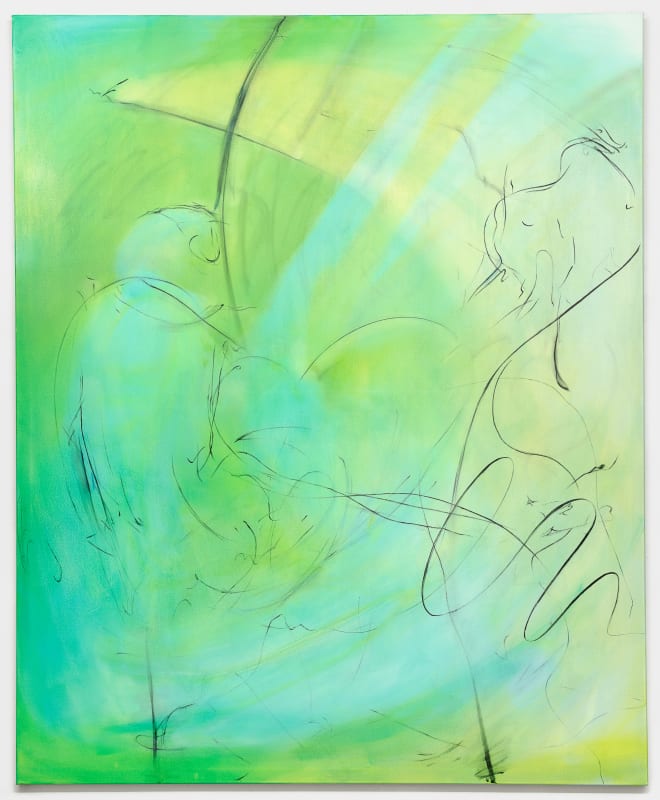Hole or whole, him and hymn, discussed disgust, which witch, scene seen, allowed not aloud, whether the weather, guilt is gilt, wine and whine, marks or Marx, the sky or this guy. Homophones like these depend on speech; once the word is spelled out the ambiguity falls away, taking along with it all the potential confusion and hilarity that can ensue when the right sound is heard but with the wrong meaning attached.
How about in painting? The marks are inscribed on a steady surface, but in their capacity for pluralised signification, a painting’s marks might be closer to airborne speech than to the spelled-out word. There is something homophonic at work in Julia Dubsky’s recent paintings, seven of which are presented in The Marshland Akimbo. Like sounds that can point in several directions at once, these paintings are sites where multiple appearances coincide in a single set of marks – with gathered elements involving a variety of unsettled figurations. Suggested ear under a spiral, x’s, loops, smudgy arches, faces fraying at the edges, a lot of maybe-eyes…
It’s remarkable how little it takes for us to ‘see’ a face: just a pair of round-ish shapes and we are looking at ourselves being looked back at – such is the inter-subjective readiness and paranoid imaginativeness of perception. Eyes make pictures more like ‘I’s; they animate an agency which implicates us by returning our gaze. When the eyes started showing up in these paintings, Dubsky recalls, it was “as though the observed picture – like a sleeping subject – had opened an eye to check whether it was being watched.”
A small painting with at least one eye, Van Dyke Brown and Studio Dust derives its name in part from Van Dyke brown, a deep earthy colour which was originally made from iron oxide-rich peat and soil, and which is named after the Flemish Baroque painter Anthony van Dyck. This painting also features Torrit Grey, a paint made by Gamblin out of pigment dust collected annually from the manufacturer’s air filtration system – a system called Donaldson Torit, after which the colour is named (with one ‘r’ added, so it can be the same word without being the same word, to avoid copyright infringement). A painting named after a paint which is named after a painter – in a colour mis-named after the industrial dust collector where it was found, as the accumulated by-product of commercial paint manufacturing.
Permanent Light, Permanent Deep is another painting named after paint; the title is drawn from the names of two oil paints produced by the manufacturer Williamsburg: Permanent Yellow Light and Permanent Yellow Deep. What’s seen in the painting is matter distributed over a surface – but there is no anti-illusionistic literalism here, as if it would ever be possible to not also read into what we are presented with. Permanent Light, Permanent Deep is one of three large-scale paintings in The Marshland Akimbo where a greenness was arrived at indirectly, with a cobalt blue painted translucently over a cool yellow. To prevent mixing, the yellow layer was completely dried before the blue came onto the scene, and the result is an oddly behaved sort of green: a green that keeps retreating from view, and then reappearing as if in quotation marks.
“The Curiosity” is a silvery painting with an emergent face, whose name, which includes quotation marks, is the slightly awkwardly translated name of a very small painting in The Louvre by Jean-Honoré Fragonard, Les Curieuses. His figuration of curiosity has two young women hiding behind, and peeking out of, and being exposed through, openings in the draped silver-grey fabric of curtains that would otherwise occupy the whole pictorial field. Without being a tribute to or new version of the French Rococo picture, Dubsky’s painting of curiosity poses a question about what happens when something shares a name with something that it isn’t.
Like the paintings they’re attached to, these re-purposed and citational titles function homonymously, because they point in more than one direction. Not infinite directions, as if anything can be arbitrarily interchangeable with anything else – but also not as meaning confined in isolation, as if a mark or gesture or syllable or name can only be affixed with a single referent.
Text by Amelia Groom
Julia Dubsky (b. 1990, Dublin) based in Berlin, graduated from the National College of Art and Design in 2016.Currently in the MA class of Jutta Koether in HfBK Hamburg. Recipient of the Temple Bar Gallery and StudiosRecent Graduate Residency Award in April 2017 until May 2018; Salon of Good Time solo residency exhibition inTemple Bar Gallery, Dublin (2018); Basic Space Artist Talk, Dublin City Gallery The Hugh Lane (2018).

